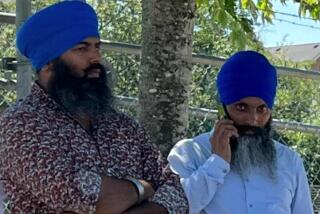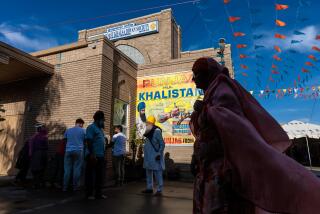Sikh Unrest: Roots Are Not Persecution
- Share via
IN THE PUNJAB, INDIA — Driving through the countryside of this lush green part of India, with the intoxicating smell of the country’s richest land pouring in through the car windows, it is hard to imagine a problem here.
For the first time since the Indian army raid on the Sikhs’ Golden Temple at Amritsar in June, 1984, foreign reporters have been allowed into the state of Punjab. Indian Prime Minister Rajiv Gandhi reached an accord last month with the leaders of the main Sikh political party here, the Akali Dal, and this was seen as an opportunity for the government to show off the newly tranquil situation.
A peaceful Punjab is one of the more impressive sights in all South Asia. It is here that the so-called Green Revolution, brought about with hybrid dwarf wheats and intense fertilization, has had its greatest victories. This is especially evident near Jullundur, in the center of the state, in what is known as the doaba-- the land of the two rivers, the Beas and the Sutlej. In all India there is no richer, more productive or more important soil than in this fertile wedge.
This is the heart of India’s Iowa: 60% of the grain needed for India’s 740 million people is grown in and around the doaba. This land is India’s only cushion between enough-to-go-around and famine, between self-sufficiency and foreign dependency.
The 20-year agricultural boom has made the Punjab so prosperous that several writers have suggested it is not part of the Third World, but the First. The fleets of tractors on the roads make it seem so, as do the rambling brick homes, and the television antennas on nearly every house instead of only at a single central building, as in most Indian villages. Everything here seems bigger, bolder, greener.
Clearly, the Sikh separatist movement that has bloodied the Punjab and other parts of northern India for the past four years was not born in any traditional milieu for revolt. The majority Sikh population--estimated at 52% to 60% of the state’s total--suffers no economic deprivation.
Sikhs, who are particularly fond of buttermilk and meat dishes cooked in butter, have the highest calorie intake of any Indian ethnic group. Many Sikh men, six-foot-plus with full beards and brightly colored turbans, are proud of their full round bellies, a sign of wealth.
Sikh politicians argue that Sikhs are victims of government discrimination in jobs and appointments. But government statistics disprove this. In fact, Sikhs have been given extraordinarily special treatment in democratic India.
Although they account for only 2% of the national population, they make up more than 8% of the government work force, including the elite Administrative Service, and more than 7% of the armed forces personnel. The president of India, Zail Singh, is a Sikh, as is the governor of the Reserve Bank of India. Arun Singh, Gandhi’s most influential adviser, is also a Sikh, though not a bearded khalsa (pure) Sikh or a devoutly religious person.
Nowhere is there convincing evidence that Sikhs suffer the kind of ethnic and religious prejudice faced by the Tamils in Sri Lanka, for example, or the Shia Muslims of Pakistan.
Of course, the Sikhs have never been impressed by the demographics of democracy. There are simply not enough Sikhs--only 15 million in India--for them to make any argument based on numbers. So in the style of the Texas Rangers (“one riot, one Ranger”) the Sikhs argue that they are superior, physically and intellectually, to any other ethnic group in India.
The main Sikh argument is not that they should have proportional representation in government. It is by merit of their perceived superiority that they deserve more. In the accord signed July 24 with Gandhi, the Sikh leaders obtained a promise that military appointments will be made in the future on the basis of merit rather than by quota.
Most Sikhs feel that in any sort of competition between a Sikh and a Hindu or a Muslim, the Sikh will easily triumph. The Sikhs chant a prayer with a refrain that says “the khalsa shall rule.” It is because of this kind of attitude that many Hindus and other non-Sikhs characterize Sikhs as bullies.
Most modern Sikh historians contend that despite all the strutting braggadocio of the Sikhs, the main reason for the conflict with the Indian government and the drive for a separate state is the Sikh fear that they will be eliminated as a separate religion through assimilation by the Hindus or corruption by Western-style prosperity.
Harchand Singh Longowal, president of the Akali Dal (“Army of Immortals”), who signed the agreement with Gandhi, has said that the Sikhs’ main concern is the “genuine foreboding that they will lose their identity in the vast ocean of the overwhelming Hindu majority.”
Jarnail Singh Bhindranwale, the militant Sikh leader whose armed followers took over the Golden Temple and held it until they were ousted by the army in a fight that cost the lives of many Sikhs and Indian army men--some of whom who were also Sikhs--preached that Sikhs were being corrupted by Hinduism and Western cultures.
Ideas and clothing and Western customs brought back to Punjab by the 200,000 or more Sikh males living abroad are to be shunned, Bhindranwale insisted, and those who preach ecumenism or even the secularism contained in the Indian constitution should be banned, even killed.
It can be argued that the violence and strife of the Indian Punjab is not a struggle against oppression or economic hardship. In fact, it is at root a struggle for survival by Sikh fundamentalists. Like fundamentalist movements elsewhere in the world--in the Arab world and in the United States--it calls for a return to the values of the past.
More to Read
Sign up for Essential California
The most important California stories and recommendations in your inbox every morning.
You may occasionally receive promotional content from the Los Angeles Times.












